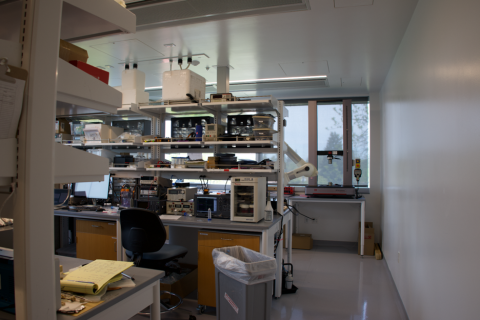
Editor's note: This article was produced by a student participating in the course J477/577: Strategic Science Communication, a collaboration between the School of Journalism and Communication’s Science Communication Minor program and the Research Communications unit in the Office of the Vice President for Research and Innovation.
Among the 13 independent faculty-led labs at University of Oregon’s Phil and Penny Knight Campus for Accelerating Scientific Impact, Keat Ghee Ong leads a lab whose research focuses on developing medical sensor technology.

His lab is currently working on sensors that can be placed inside the human body and will have the ability to monitor and provide information about the body during recovery. For example, one sensor under development can measure the amount of force applied on an injured area, which can help monitor recovery following surgery.
This specific sensor is going through the process of obtaining US Food and Drug Administration approval, following years of research, development, and pre-clinical experiments to assure that the technology is both safe and effective. Once FDA approval is granted, they can begin clinical trials in humans.
“Once we know it is safe and effective in the living body, then we can go to human [trials], so it’s a long process, and takes many, many years,” Ong said.
Ong, professor of bioengineering, is not only the facility leader of the Ong Lab at Knight Campus, he is also the owner of a startup company, Penderia Technologies Inc., located in Eugene. Penderia was launched with support from Knight Campus and the UO’s Industry, Innovation, and Translation unit, which helps faculty members spin out companies or license their intellectual property.
Prior to joining the UO, Ong’s research focused on researching and developing basic medical sensors, rather than translating the research results from the lab into the commercial market. Ong said that the Knight Campus mission is what drew him to Oregon, especially with its environment that encourages innovation and startup culture."
“The key word is impact,” Ong said. “Whatever we do here on this campus, we need to figure out how does it make an actually significant impact.”
He chose to apply his expertise in sensor technology to medical research not only because of his desire to help people but also because he feels that a lot of medical treatments lacks useful sensors and have rooms for improvement and innovation.
“A lot of those types of technologies are based on one very simple physics concept,” Ong said, “But how do we use this concept [resonant circuit] for something that is medically relevant? That is what we are doing here.”

Ong’s lab focuses on early-stage technology innovation and working with new ideas, rather than more late-stage technology development. He considers innovation to be what is the most special about what they do.
“I think that the devil is in the details, so it means that the concept is simple, but to make it work, it needs a lot of expertise,” Ong said. “The background, the expertise is not developed overnight, we take a long time to get the right people and the right environment, the right facility, and so on.”
Ong’s ultimate goal is to be able to help people with his work.
“I really want to see a UO technology that comes from my lab be used by the community,” he said. “It’s all good to do it in the lab, publish a paper, go to conferences, but after a while something’s always missing, right? I come up with these ideas and designs to help people.”
